Driving the Mercedes-Benz F-Cell World Tour
Stealing a scene from the Jetsons, our little fluorescent green sedan zooms down the Autobahn at triple-digit speeds, puffing little white plumes of water vapor in its turbulent wake. While this animated family of the future cruised in a bubble-top "capsule car" (it folded conveniently into a briefcase, if you recall), we are whisking through Europe in a hydrogen-powered B-Class F-Cell.
The prime-time Jetsons sitcom was penned by artists in a Hanna-Barbera animation studio in the early 1960s. Not so our transport. The compact F-Cell was engineered and built by the team at Mercedes-Benz - the same German company credited with building the world's first combustion-powered automobile 125 years ago. This morning, the automaker is leading the charge to introduce the world to hydrogen as it feels the clean technology is finally mature enough for widespread use. Engaging the media to drive its point home, the company has launched an around-the-globe excursion called, appropriately enough, the "Mercedes-Benz F-Cell World Tour." We've been invited to take the wheel during the first leg to Paris, starting at the company's headquarters in Germany.
Continue reading How the Mercedes-Benz F-Cell left us both stranded and impressed...
Mercedes-Benz F-Cell World Tour – Click above for high-res image gallery
Stealing a scene from the Jetsons, our little fluorescent green sedan zooms down the Autobahn at triple-digit speeds, puffing little white plumes of water vapor in its turbulent wake. While this animated family of the future cruised in a bubble-top "capsule car" (it folded conveniently into a briefcase, if you recall), we are whisking through Europe in a hydrogen-powered B-Class F-Cell.
The prime-time Jetsons sitcom was penned by artists in a Hanna-Barbera animation studio in the early 1960s. Not so our transport. The compact F-Cell was engineered and built by the team at Mercedes-Benz - the same German company credited with building the world's first combustion-powered automobile 125 years ago. This morning, the automaker is leading the charge to introduce the world to hydrogen as it feels the clean technology is finally mature enough for widespread use. Engaging the media to drive its point home, the company has launched an around-the-globe excursion called, appropriately enough, the "Mercedes-Benz F-Cell World Tour." We've been invited to take the wheel during the first leg to Paris, starting at the company's headquarters in Germany.
Continue reading How the Mercedes-Benz F-Cell left us both stranded and impressed...
Photos copyright ©2011 Michael Harley / AOL and Mercedes-Benz
Stuttgart is unpleasantly cold in the middle of winter. It's the crack of dawn, the sky is clear and the ambient temperature hovers at about 15 degrees Fahrenheit. I'm standing in the middle of a large, ice-laden concrete parking lot next to a bright green Mercedes-Benz B-Class sedan. The location is the automaker's plant in Stuttgart-Möhringen, Germany. Thankfully, I'm not the only person out here.
Local media, documentary crews, dignitaries (including Daimler AG board member Dr. Thomas Weber) and a long list of support personnel are also shivering alongside me. In a scaled-down version of NASA activity minutes before a shuttle launch, engineers and staff are triple-checking each of the three small hydrogen-powered vehicles as we prepare to start our globe-circling journey on the Mercedes-Benz F-Cell World Drive.
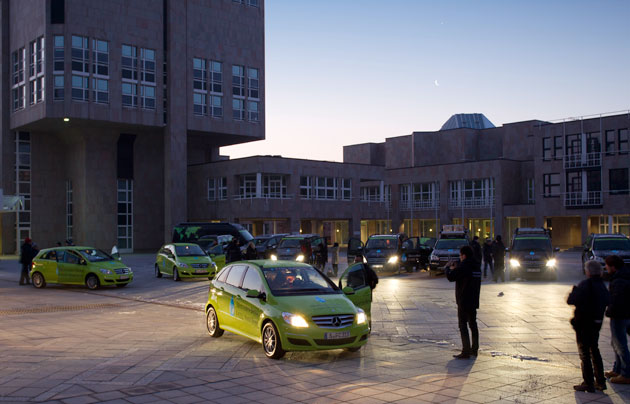
While nearly everyone is speaking native German, standing alongside me is fellow American Jonny Lieberman (the former Autoblog scribe who is now working the Senior Editor desk at Motor Trend). Jonny and I are tasked to drive the first leg of the well-publicized tour in "Car #2." It's not just the two Yanks in this particular compact B-Class, as Mercedes has also embedded Markus Stier, a German journalist with Auto Motor und Sport, in our car for the long haul. Not only will Markus numbly sit in the B-Class for most of its round-the-world tour, but he'll double as our translator. Markus will be busy.
According to our typically rigid German schedule, a countdown is in progress. We depart in less than ten minutes. A handful of people eagerly help us pack all of our bags into the rear luggage compartment of the hatchback - the B-Class surprisingly swallows three roll-on suitcases, several backpacks and each of our camera bags.
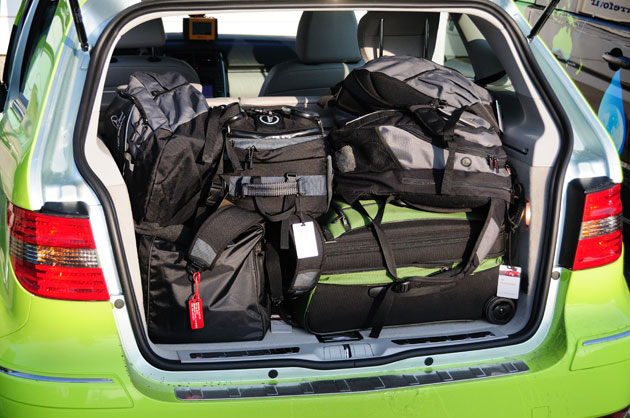
Strapped into the driver's seat in the cozy passenger cabin, my six-foot two-inch frame is very comfortable. As an unexpected bonus, we have heated seats and our vehicle has been at "idle" long enough to bring the atmosphere up to the mid-70s (this will come back to haunt us). It's time to depart, so I maneuver in behind the Chinese journalists (in "Car #1") and in front of the German engineers (in "Car #3"). Under the veil of a waving flag and the raspy noise of a poorly-blown vuvuzela, our three F-Cell vehicles depart slowly as the frostbitten crowd claps and cheers.
Trailing closely is a fleet of following Mercedes-Benz GL-Class SUVs, Sprinters and Vianos (a passenger variant of the automaker's V-Class commercial panel van) filled with nearly two-dozen support crew who will be shadowing the cars during the hydrogen-powered odyssey. In the event that we lose visible contact with our trailing convoy, each vehicle has been equipped with stock GPS satellite navigation, an aftermarket Tripy II GPS-enabled on- and off-road navigation system, two-way radio, cell phone, Iridium satellite phone, paper maps and an integrated iridium satellite modem allowing us to be tracked seemingly anywhere on the planet.
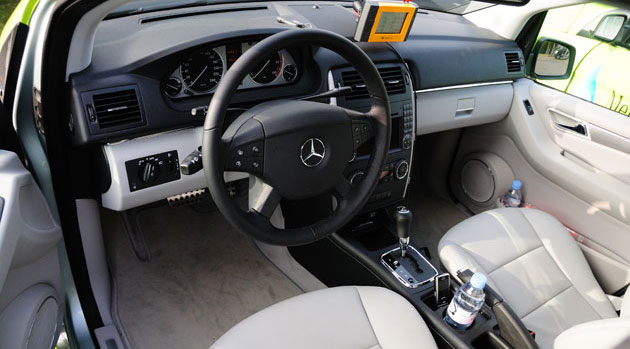
Aside from the bright-green paint and bold graphics, our special B-Class appears identical to its gasoline and diesel siblings running around Europe's streets. Yet, that is far from the case. The B-Class F-Cell is a very unique hydrogen-powered four-door that has been around for nearly two years. Tucked out of the way under the double floor, just under the rear passenger seats, are three carbon-fiber cylinders. Each is filled with high-pressure (700 bar, or 10,200 psi) hydrogen gas. An innovative fuel cell stack, hidden under the driver and front passenger floor, mixes the hydrogen with atmospheric oxygen to generate electric current. The electricity is used to power a single high-torque electric motor under the front hood - sending power through a single-speed gearbox to the front wheels. A lithium-ion battery pack, charged by the fuel stack and regenerative braking, is tucked under the rear cargo floor. It is used to boost the F-Cell's acceleration.
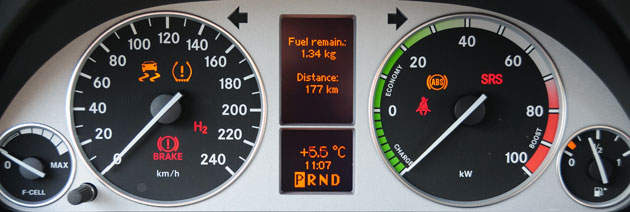
Navigating through the surface streets on our way toward the Autobahn, I find the B-Class accelerator pedal delivers what Mercedes-Benz promises - the acceleration feel of a traditional 2.0-liter gasoline-powered engine. The 100 kW motor puts out 136 horsepower (214 pound-feet of torque), pulling an unladen F-Cell to 60 mph in just over 10 seconds. It feels peppy, but not exactly quick. Nevertheless, it is still much more engaging to drive than any current Toyota Prius.
Our F-Cell is quite a bit more sluggish because we've got three large male adults and their full luggage aboard. Add our mass to the vehicle's empty curb weight (3,989 pounds) and our adjusted gross vehicle weight is about 4,750 pounds. That puts us more than 150 pounds over the permitted max gross vehicle weight, according to the automaker's own handbook (another oversight that will come back to bite us).
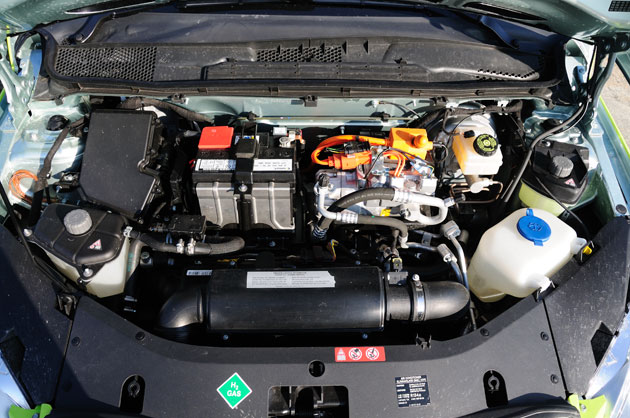
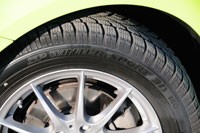
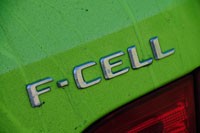
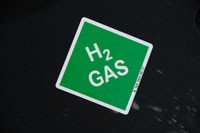
Mercedes-Benz has spent months methodically planning the F-Cell World Drive route. Since the high-pressure hydrogen fuel infrastructure doesn't exist except in limited markets (even pumps that are designed to service a Honda Clarity won't work), a special service fuel/pump truck will be part of the caravan covering nearly 19,000 driven miles - 15 different countries - over the next 125 days.
Jonny, Markus and I will be together for two days, driving from Stuttgart to the French capital. We will spend the night in Reims, France, after a refueling stop mid-way (about 175 miles after our early morning departure). In theory, with full tanks (8.2 pounds of hydrogen), the range of the F-Cell is about 240 miles under optimal conditions.
The early Sunday morning Autobahn is surprisingly empty in the middle of winter. There is just a smattering of cars on the road, all hanging in the right lanes. While outside temperatures are numbingly cold, the road is dry and we are riding on brand-new speed-rated winter tires. I therefore do what any self-respecting, warm-blooded American car enthusiast would do under such conditions - I floor the accelerator pedal. And I hold it there.
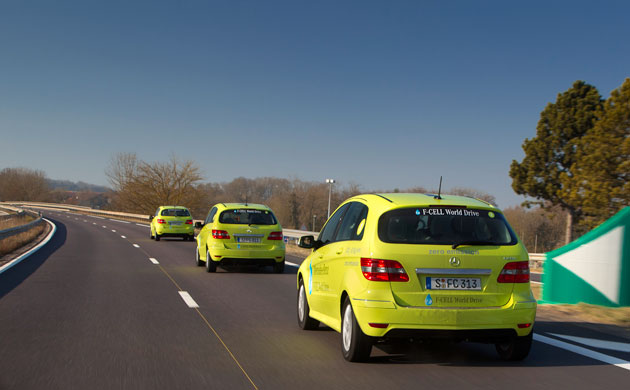
The B-Class F-Cell doesn't take off like a rocket. Instead, with the deliberation of a small-displacement economy car, acceleration builds slowly and consistently. The speedometer is in kilometers-per-hour, so all in the car count out as the needle sweeps slowly past the numerals. 100, 110, 120... pause for a moment as we are going up a slight grade. Down the other side, 130, 140, 150... the B-Class is absolutely stable and content. The road flattens, and I press on... 160, 170, um 180... that's it. The electronic limiter pulls in the reins and the speed falls back and sticks at 175 km/h (just under 110 mph). It's hardly supercar territory, but the velocity is more than admirable for a vehicle the produces absolutely zero emissions. Again, the speed is just a token number. More impressive is the stability and comfort of the hydrogen-powered sedan spewing only water vapor at triple-digit speeds. The F-Cell feels as if it can hold this sort of velocity all day.
The next 45 minutes are filled with high-speed driving (90-plus mph) with occasional bursts to the electrically-limited top speed. Car #1, filled with Chinese media, are mimicking our fast driving style and we shadow each other for a while. The Germans in Car #3, on the other hand, seem to be hypermiling it, and disappear in the rearview mirror after about 30 seconds. We are warm, there is no traffic on the typically congested autobahn and conversation is good. Our spirits are high. That is, until our mobile phone rings.
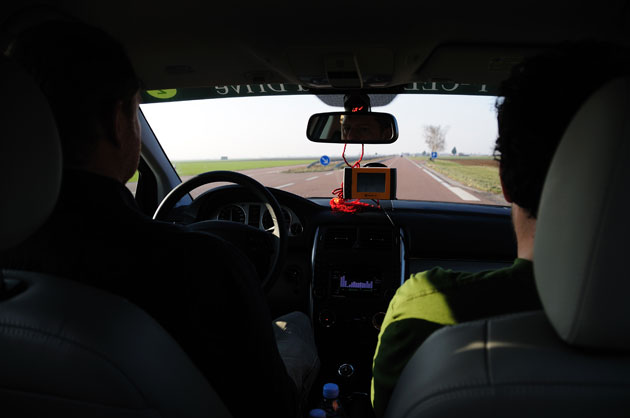
On the phone is Melanie, one of our Mercedes-Benz handlers. She immediately asks to talk to Markus. A short German conversation ensues. Jonny and I don't understand the words, but the tone in the translated message is obvious - we need to slow our pace. A glance at the fuel gauge shows us down to about half-a-tank. At this burn rate we will make it to France, but not to our fuel stop. From this point forwards, our "consumption gauge" (it replaces the tachometer on the F-Cell) must be kept in the efficient 20-percent zone, says our German friend.
While the required hydrogen fuel stations are few and far between, there are plenty of human calorie pumps along our route. We pull into a truck stop (with the Mercedes-Benz convoy in tow) and order cappuccinos and chocolate croissants. Like sophomores in high school defending a low score on an unannounced pop-quiz, we discuss our fuel consumption with Melanie and Agathe, two always-smiling members of the Mercedes team.
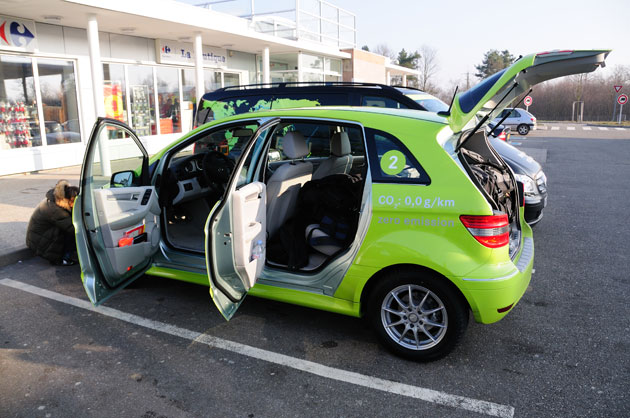
First, burdened with weight over the limit, our F-Cell is requiring a very heavy foot on the throttle. This translates to consumption rates that put us far over the published values. Second, it doesn't help that we have been aggressively pushing or little B-Class to Mach .14, way over what any reasonable "eco-minded" future owners might choose to do with such a machine. Lastly, the German engineers also admit that leaving the vehicles at "idle" to keep them warm was not a good idea. We unnecessarily burned through precious hydrogen in the parking lot. In simple terms, we departed with tanks that were not full. (*Insert German explicative here*).
Jonny takes the wheel in a scheduled driver change, as we are half-way to the fuel stop. He is instructed to keep things at about 110 km/h (under 70 mph). He does, and our burn rate slows accordingly. However, it is a bit too late. Crossing through a toll booth, a light on the dash illuminates to warn us that we are on "Reserve Fuel." We pull over for an impromptu meeting with the Mercedes engineers. All of us are standing in the cold wind. We plead to press on.
Like Lovell, Swigert and Haise, forced to cut power onboard a crippled Apollo 13 spacecraft (also powered by hydrogen), we shut down all unnecessary electrical items (heated seats, HVAC, headlights, etc...) to conserve our fuel. We also slow to 55 mph - a move that immediately pisses off the French drivers behind us. We momentarily consider throwing luggage out the window, but it is simply too cold to open them. Crossing the rolling French countryside, each long grade sucks precious hydrogen from our tanks. Things aren't looking good.
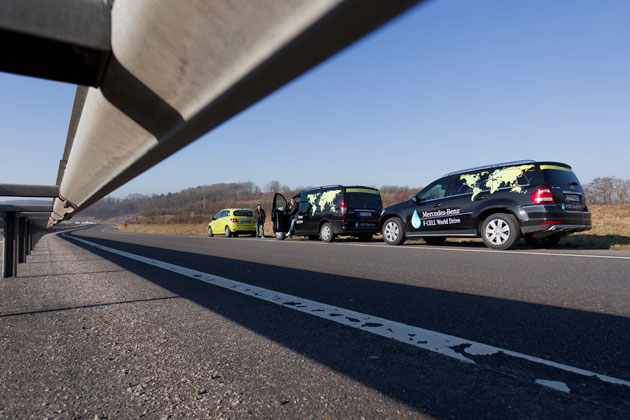
With the fuel needle now below the empty mark, and less than half-a-pound of hydrogen left in the tanks (precisely .19 kilograms, according to the dashboard display), it isn't safe for us to continue - according to those who should know, the F-Cell loses steering and braking assist when the tanks are completely depleted. We pull over on the side of the French highway and shut the car down.
Moments later, the Mercedes-Benz support convoy converges upon us. So do the French police. The Germans, charged with explaining to the French authorities the need for the growing assemblage disrupting traffic on the side of the road, are not impressed.
As our fluorescent-green F-Cell is winched into a truck, we are told that the Chinese have also run out of hydrogen, but it doesn't make us feel any better. A well-heated gasoline-powered support van gives us a ride to the fueling station, where we meet up with the other two teams.
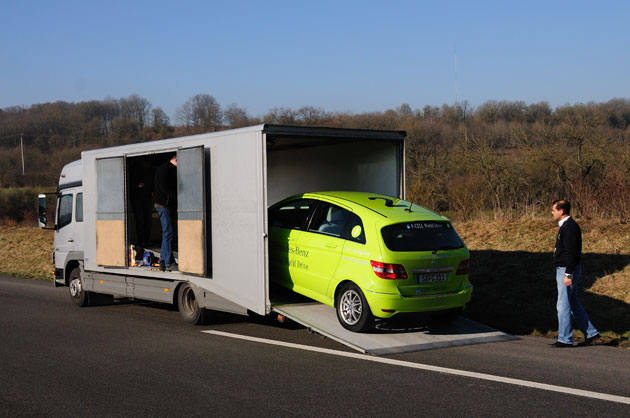
In theory, filling the hydrogen tanks takes only three minutes. But that only works with established fueling stations (as of today, there are only about 200 worldwide). Our mobile fueling truck needs to be assembled, and it needs to process the gas before it goes into our tanks. Simply put, our mobile fuel/pump truck needs to take compressed hydrogen from steel cylinders kept at 7,500 psi and bring it up to 14,700 psi to pump it into the F-Cell's tanks where it is stored at 10,200 psi. The single-piston compressor mounted inside the truck is huge, and it wildly shakes the entire vehicle while it is in action - we nickname it the "humpy truck" for obvious reasons.
Fuel tanks full and our minds burdened with countless verbal instructions on how to maximize efficiency and range, the three of us re-board Car #2 and hit the pavement for Reims. Our arrival, just a few hours later, was textbook perfect. The Germans are smiling again.
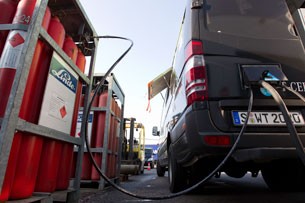
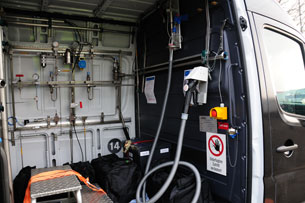
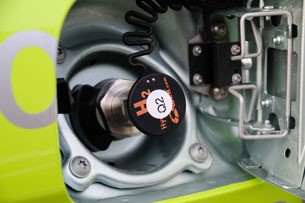
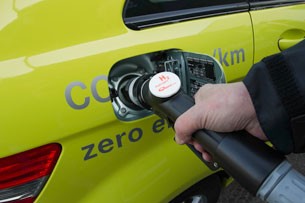
After a thorough vehicle inspection, and another refueling, we set off for Paris the next morning. With our heavy luggage stowed in one of the support vehicles and our velocity capped by "eco-reasonable" speed limits, we are able to enjoy the drive. The countryside is frozen, but still very beautiful. At one point, the road blends into the main straight of the old Reims-Gueux race circuit, home of the "Grand Prix de la Marne" (the track was established in 1926). We stop to take pictures. The balance of our drive to Paris, only a couple more hours down the road, is again uneventful. As stipulated by our Mercedes-Benz guidebook, we arrive without incident and with more than sufficient hydrogen reserves in our tank.
That evening, while sitting at the gate at Charles de Gaulle Airport watching my Boeing 767-300ER as it is loaded with 24,100 gallons of kerosene fuel for a flight back to the States, I firmly conclude that Mercedes-Benz will never convince me that hydrogen gas is going to end the world's dependence on fossil fuels.
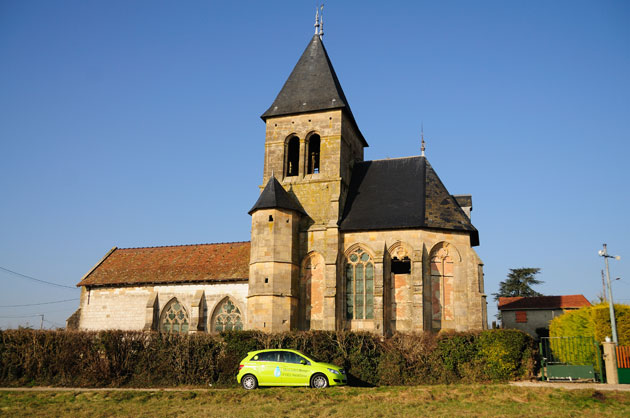
Thankfully, this isn't the automaker's mission. Mercedes-Benz has organized the F-Cell World Drive to bring attention to hydrogen as a technically mature locally emissions-free alternative fuel. While long-distance cross-border road trips may not be hydrogen's near-future forte, the automaker is convinced of its viability with the proper infrastructure. I'll raise my glass to that.
While I'm no longer spewing water vapor out of my exhaust pipe, driving the first leg of this journey genuinely educated me. The Mercedes-Benz B-Class F-Cell performed flawlessly during the 400-mile stint, regardless of being frozen, overloaded and flogged nearly constantly. The small vehicle's Achilles heel wasn't the engineering, the powertrain or the technology - it was solely blamed on the non-existing hydrogen infrastructure. In terms of shedding global light on this gaping issue, maybe the early loss of two vehicles to fuel starvation wasn't such a bad occurrence after all.
Photos copyright ©2011 Michael Harley / AOL and Mercedes-Benz



Sign in to post
Please sign in to leave a comment.
Continue